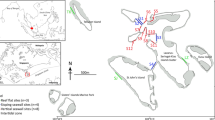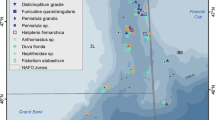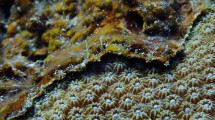Abstract
Colonies of the soft coralSinularia flexibilis (Quoy & Gaimard) (Coelenterata, Octocorallia) were collected at Lizard Island (14°40′S and 145°28′E) Research Station. Extraction of the corals and quantitative chemical analysis for the three major diterpene components, flexibilide, dihydroflexibilide, and sinulariolide, afforded average ratios of 4∶3∶1 respectively. Colonies, sized on the basis of the sterile stalk circumference, were analyzed for possible correlations between size and chemical composition. The major metabolite, flexibilide, was inversely correlated with colony size, while sinulariolide concentration showed a direct correlation. The concentration of dihydroflexibilide was independent of colony size. Samples were further analyzed with respect to site of collection. Colonies were collected at three distinct reefal sites. One was characterized by large monospecific stands ofParites cylindrica, a second was a sandy bottom site with a mixed community of soft corals and occasional scleractinians, while the third site was a very diverse reef community with many species of scleractinian corals.Sinularia flexibilis was well represented at each site, and the concentration of flexibilide and sinulariolide varied significantly among sites. The concentration of flexibilide was significantly higher at the third, highly competitive site, while the concentration of sinulariolide was highest at thePorites-dominated site. Dihydroflexibilide levels were independent of site. It seems likely that concentrations of flexibilide, a highly cytotoxic molecule involved in interference competition, and sinulariolide, a known algicide probably responsible for colony maintenance, may be influenced by their environments.
Similar content being viewed by others
References
Aceret, T.L.,Sammarco, P.W., andColl, J.C. 1991. Effects of sub-lethal doses of soft coral derived toxins on hard corals. Proceedings, Australian Marine Science Association Conference. Brisbane, Queensland, Australia.
Alino, P.M. 1989. Ecological and chemical aspects of interactions of soft corals (Octocorallia: Coelenterata). PhD dissertation. James Cook University of North Queensland, Australia.
Bowers, M.D., andStamp, N.E. 1992. Chemical variation within and between individuals ofPlantago lanceolata (Plantaginaceae).J. Chem. Ecol. 18(7):985–995.
Coll, J.C. 1992. The chemistry and chemical ecology of octocorals (Coelenterata, Octocorallia).Chem. Rev. 92:613–631.
Coll, J.C., andSammarco, P.W. 1983. Terpenoid toxins of soft corals (Cnidaria: Octocorallia): Their nature, toxicity and their ecological significance.Toxicon Suppl. 3:69–72.
Coll, J.C., Bowden, B.F., Tapiolas, D.M., andDunlap, W.C. 1982. In situ isolation of allelochemicals from soft corals (Coelenterata: Octocorallia): A totally submersible sampling apparatus.J. Exp. Mar. Biol. Ecol. 60:293–299.
Dinesen, Z. 1983. Patterns in the distribution of coral communities across the central Great Barrier Reef.Coral Reefs 1:229–236.
Gershenzon, J., andCroteau, R. 1991. Terpenoids, pp. 165–219,in G.A. Rosenthal and M.R. Berenbaum (eds.). Herbivores: Their Interactions with Secondary Plant Metabolites, 2nd ed. Academic Press, Orlando, Florida.
Lincoln, D.E., andLangenheim, J.H. 1979. Variation ofSatureja douglasii monoterpenoids in relation to light intensity and herbivory.Biochem. Syst. Ecol. 7:289–298.
Lincoln, D.E., andLangenheim, J.H. 1981. A genetic approach to monoterpenoid compositional variation inSatureja douglasii.Biochem. Syst. Ecol. 9:153–160.
Louda, S.M., andRodman, J.E. 1983. Ecological patteras in the glucosinolate contents of a native mustard,Cardamine cordifolia, in the Rocky Mountains.J. Chem. Ecol. 9:397–422.
Maida, M. 1993. Allelopathic effects of alcyonacean soft corals on the settlement and early development of scleractinian corals. PhD thesis. James Cook University, Townsville, Queensland, Australia.
Mihaliak, C.A., Couvet, D., andLincoln, D.E. 1989. Genetic and environmental contributions to variation in leaf monoand sesquiterpenes ofHeterotheca subaxillaris.Biochem. Sytem. Ecol. 17:529–533.
Rice, E.L. 1984. Allelopathy. Academic Press, New York.
Sammarco, P.W., andColl, J.C. 1988. The chemical ecology of alcyonarian corals. Coelenterata: Octocorallia, pp. 87–116,in P.J. Scheuer (ed.). Bioorganic Marine Chemistry, Vol. 2, Springer-Verlag, Berlin.
Sammarco, P.W., Coll, J.C., La Barre, S.C., andWillis, B. 1983. Competitive strategies of soft corals (Coelenterata: Octocorallia): Allelopathic effects on scleractinian corals.Coral Reefs 1:173–178.
Sammarco, P.W., Coll, J.C., andLa Barre, S.C. 1985. Competitive strategies of soft corals (Coelenterata: Octocorallia). II. Variable defensive responses and susceptibility to scleractinian corals.J. Exp. Mar. Biol. Ecol. 19:199–215.
Sokal, R.R., andRohlf, F.J. 1981. Biometry, 2nd ed. Freeman, San Francisco, 359 pp.
Tursch, B., Braekman, J.C., Daloze, D., andKaisin, M. 1978. Terpenoids from coelenterates, pp. 247–296,in P.J. Scheuer (ed.). Marine Natural Products: Chemical and Biological Perspectives, Vol. 2. Academic Press, New York.
Veron, J.E.N. 1986. Corals of Australia and Indo-Pacific. Angus & Robertson, Sydney, Australia.
Veron, J.E.N., andPichon, M. 1976. Scleractinia of eastern Australia, Part 1. Families Thamnasteriidae, Astrocoeniidae and Pociloporidae. Australian Institute of Marine Science Monograph Series, Vol. 1.
Veron, J.E.N., andPichon, M. 1979. Scleractinia of eastern Australia, Part 3. Families Agariciidae, Siderastreidae, Fungiidae, Oculinidae, Merulinidae, Mussidae, Pectiniidae, Caryophylliidae, Dendrophylliidae. Australian Institute of Marine Science Monograph Series, Vol. 4.
Veron, J.E.N., andPichon, M. 1982. Scleractinia of eastern Australia, Part 4. Families Poritidae. Australian Institute of Marine Science Monograph Series, Vol. 5.
Veron, J.E.N., andWallace, C.C. 1984. Scleractinia of eastern Australia, Part 5. Families Acroporidae. Australian Institute of Marine Science Monograph Series, Vol. 6.
Veron, J.E.N., andWijsman-Best, M. 1977. Scleractinia of eastern Australia, Part 2. Families Faviidae, Trachyphylliidae. Australian Institute of Marine Science Monograph Series, Vol. 3.
Webb, L., andColl, J.C. 1983. Effects of alcyonarian coral terpenes on scleractinian coral photosynthesis and respiration.Toxicon Suppl. 3:485–488.
Weinheimer, A.J., Matson, J.A., Hossain, M.B., andVan Der Helm, D. 1977. Marine anticancer agents sinularin and dihydro-sinularin, new cembranolide diterpenes from the soft coralSinularia flexibilis.Tetrahedron Lett. 1977:2923–2926.
Zar, J.H. 1984. Biostatistical Analysis. 2nd ed. Prentice-Hall International, Englewood Cliffs, New Jersey.
Author information
Authors and Affiliations
Rights and permissions
About this article
Cite this article
Maida, M., Carroll, A.R. & Coll, J.C. Variability of terpene content in the soft coralSinularia flexibilis (Coelenterata: Octocorallia), and its ecological implications. J Chem Ecol 19, 2285–2296 (1993). https://doi.org/10.1007/BF00979664
Received:
Accepted:
Issue Date:
DOI: https://doi.org/10.1007/BF00979664




